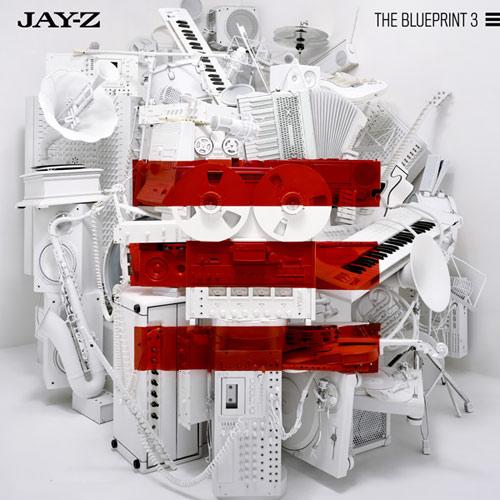Jay-Z isn’t a businessman — he’s a business, man. And when you’ve branded your image to the point where you’re simultaneously managing a clothing line, sports club and record label, it’s fair to say the Hova has landed. The new quandary becomes maintaining your self-proclaimed street cred whilst juggling decidedly non-street multi-million-dollar finances — something done in 2007 with American Gangster by hiding behind the “concept album” guise. (It wasn’t Jay-Z rapping about slingin’ heroin — it was Jay-Z channeling an American gangster who just happened to bear a strong resemblance to young Jay. The fact that he all too clearly blurred the lines between himself and his character on tracks like “Roc Boys” didn’t seem to matter; the beats, the rhymes and the flow were all at a peak — and, collectively, a welcome resurrection after the disappointment of Kingdom Come in ‘06.)
Bad news, then: Blueprint 3 isn’t nearly as good as American Gangster. The production is more excessive; the lyrics are often derivative; Jay’s rhymes are inconsistent, jumping from hot (”D.O.A.”) to cold (”Hate”). It’s more BP2 than BP1; more Kingdom Come than Reasonable Doubt. But it’s still not the flop that some critics are labeling it as.
The album’s primary fault is its length — at 15 tracks, it’s too damn long, especially since it’s relatively front-loaded — in other words: all the best stuff comes at the beginning. “What We Talkin’ About,” with its warm synths and pounding bass, is a great intro; “Thank You” recalls the neo-soul production of the album’s original predecessor; “Death of Auto-Tune” overcomes its burdensome gimmickry with a stripped-down instrumental section and a take-no-prisoners Hov. (That being said: the problem with placing an anti-auto-tune song on an album featuring songs whose main hooks include obvious usage of auto-tune is notable.)
“Run This Town,” the record’s second (and underrated) single featuring Kanye and Rihanna, works even better within context of the album; but Jay is overshadowed by ‘Ye, and he never quite recovers for the remainder of his album; “Real As It Gets” is good but strangely familiar, and “Empire State of Mind” — while definitely one of the album’s better tracks — is basically a remake of “Brooklyn Go Hard,” featuring the exact same unique vocal inflections on its verses and chorus.
“A Star is Born,” “Venus vs. Mars” and “So Ambitious” are largely forgettable. You’re left wondering why “History,” “Jockin’ Jay-Z” and “Swagga Like Us” (all tracks released since ‘07, before the album got bumped back multiple times) were left on the cutting room floor in favour of these turkeys. Did Jay and his team of producers really think this material was up to par?
Interestingly enough, the impression I was left with after Blueprint 3 was over? Jay has been listening to some indie rock — I’m not sure what happened to that missing MGMT track, but the production as a whole reeks of hipster influence. (Even the album artwork, the first of Jay’s not to feature himself on the front cover, seems unmistakably…indie. Add to the evidence: Jay was spotted moving to the sweet rhythms of Grizzly Bear at a show in NYC last week.)
As interesting a concept as this may be — indie rock hip-hop? — it’s not entirely effective on Blueprint 3, and you’re left wondering how much better this all might have been if we sensed that Jay had a purpose. Jay’s rise to fame has been a blessing and a curse (BP2 pun intended) — it’s enabled him to be the biggest and, for a while, the best; it’s also undermined his outlook. Everything here is far too insulated — as good as “Run This Town” may be, you’re left with the feeling that Jay actually believes those esoteric lyrics. Surrounded by an army of yes-men and enablers, it would be hard for anyone not to buy into their own name — especially when their name is spread across so many ventures — but, you know, the best rap albums — Reasonable Doubt and American Gangster included — usually channel the hunger, strive and purpose of an underdog. Jay doesn’t have that drive anymore because he is on top — and it might take him hitting rock bottom again before we ever hear something as bold and beautiful as the first Blueprint. In the meantime, we’ve got a relatively above-average work from an artist who’s proven himself capable of so much more.

